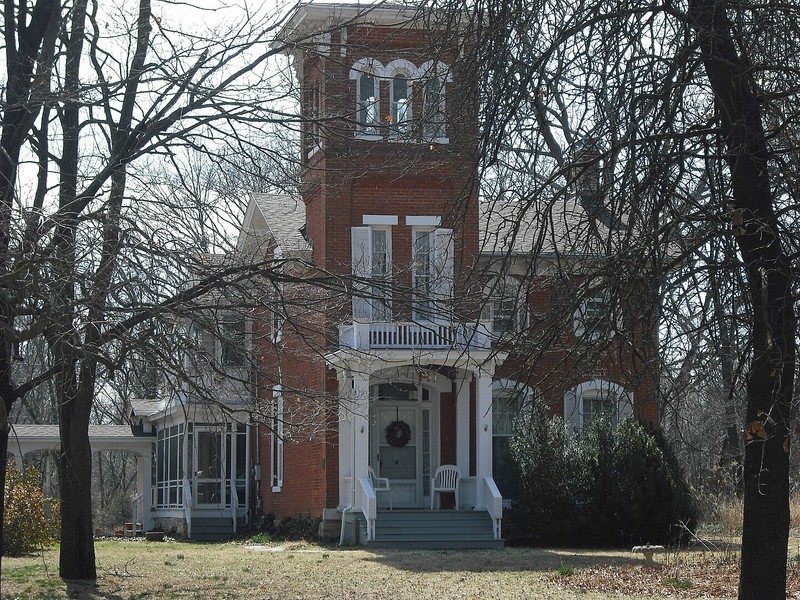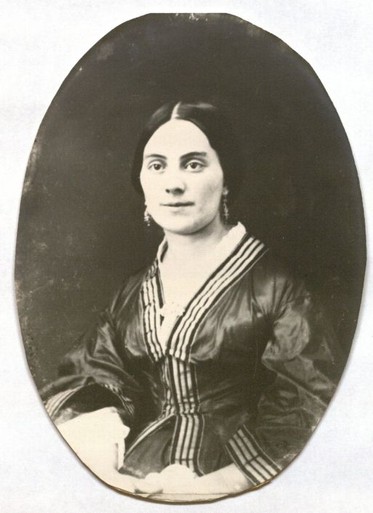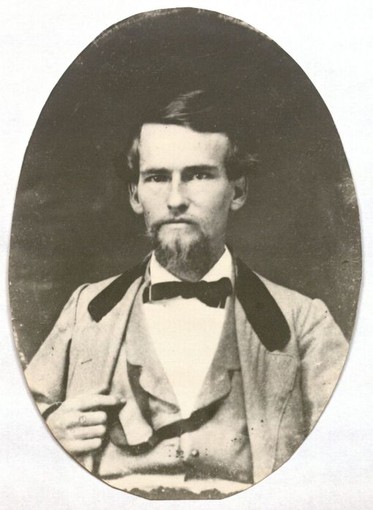Samuel A. and Kate Riggs House
Introduction
Text-to-speech Audio
Samuel A. Riggs, a politician and government lawyer, had this historic house built from 1863 to 1864. The home suffered substantial damage during "Quantrill's Raid" of Lawrence on August 21, 1863, but was one of the few structures that survived the raid and continues to serve as a private home. Pro-Confederate raider William Quantrill and his guerilla-style soldiers destroyed much of the town, set fire to a substantial number of businesses, and killed at least 150 people. Riggs only escaped being shot during the raid because of his wife Kate's bravery, and he resumed construction of the home in September 1864. To this day, some burn marks are still visible on the brick walls
Images
Samuel A. and Kate Riggs House

Kate Riggs

Samuel A. Riggs

Backstory and Context
Text-to-speech Audio
Riggs, born in Ohio in 1835 and a graduate of the Cincinnati Law School, was admitted to the bar in Ohio in 1858 and came to Lawrence, Kansas, in April 1859. He established a law practice in Lawrence and became active in the Republican Party, becoming the region's District Attorney (D.A.) within his first year in Lawrence. He won reelection in 1862 and 1864.
During his time as a local D.A., he built the historic home, one of many structures burnt by Quantrill's forces. Although the exact reason for the raid remains a mystery, the motivation for the raid ultimately lay in the fact that pro-slavery and Confederate sympathizers disliked Lawrence because it played a primary role in keeping Kansas a free state (antislavery). Additionally, Lawrence resident and Union brigadier general James H. Lane (who later served as a U.S. Senator) led "Jayhawker" raids into Missouri, notably burning the town of Osceola in 1861. Whatever the motivation, around 5 a.m. on August 21, 1863, General William C. Quantrill led a band of around 300 guerrilla soldiers in a surprise attack on Lawrence, burning most of the businesses in town and killing more than 150 men (and wounding many more).
Riggs narrowly escaped death while taking shelter in his old home on Rhode Island Street in Lawrence. A raider arrived at the Riggs' old home and shouted for Samuel to come outside. As he aimed his pistol, Kate Riggs (Samuel's wife) bravely grabbed the horse's bridle, which made the horse bolt. The shooter lost his balance and could not get off a clean shot. The horse reportedly dragged Kate around the yard. When the horse and shooter got settled, the raider again took aim, only to have Kate again thwart his efforts when she grabbed the horse's reins; Samuel Riggs escaped.
Ultimately, Quantrill's raid provided no lasting military value for the Confederacy, but it did force Riggs and the rest of Lawrence to rebuild almost from scratch. At the time of the raid, Riggs' builders had built the walls and framework for the windows and doors; the fire burned all the wood. Riggs resumed construction after the raid, moving into the home in November 1864.
After the war, Riggs left his D.A. position to serve in the Kansas State Senate. Shortly thereafter, he became U.S. District Attorney for Kansas, where he helped codify the Kansas laws. By the 1870s, Riggs fled the Republican Party to join the Independent Reform Party. He lost in his bid to become a U.S. Congressman in 1872, but he won an election in 1879 to serve in the Kansas House of Representatives as part of the new party. But, he switched parties again in 1883 when he joined the Democratic Party. Nevertheless, Riggs lost his second attempt to become a U.S. Congressman. He did not serve public office again until he served two terms as state district court judge from 1896 to 1900.
Samuel and Kate lived in the historic home for fifty years. They moved in 1914 to Ann Arbor to be closer to their son. Still, the family rented the house to tenants from 1914 until they sold it in 1931, nearly seventy years after Quantrill's raid. In the 1970s, a University of Kansas archaeology class made excavations in the builder's trench around the house. The group discovered period artifacts and evidence of the fire that damaged the Riggs' home.
Sources
Epps, Kristen. "Quantrill's Raid on Lawrence" Civil War on the Western Border: The Missouri-Kansas Conflict, 1854-1865. The Kansas City Public Library. Accessed Friday, February 2, 2024. https://civilwaronthewesternborder.org/encyclopedia/quantrills-raid-lawrence.
Pankratz, Richard and Cornelia Wvma. "Nomination Form: Riggs, Samuel A. House." National Register of Historic Places. nps.gov. 1977. https://npgallery.nps.gov/GetAsset/256ddca0-b649-4f03-9ae1-bb359f239408.
"Quantrill's Raid: I Am Alive" Kansas University Libraries. ku.edu. Accessed February 2, 2024. https://exhibits.lib.ku.edu/exhibits/show/quantrill/after/alive.
Riggs, Samuel A. "Personal Experiences of Samuel A Riggs." pddoc.com. Accessed February 2, 2024. https://www.pddoc.com/skedaddle/012/personal_experiences_of_samuel_a_riggs.htm.
By Bhall87 at English Wikipedia, CC BY-SA 3.0, https://commons.wikimedia.org/w/index.php?curid=17979190
KU Libraries: https://exhibits.lib.ku.edu/items/show/5996
KU Libraries: https://exhibits.lib.ku.edu/items/show/5996
